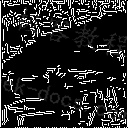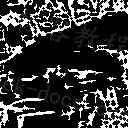Canny边缘检测之后,进行N=1的闭处理吧。
闭运算,即先进行N次膨胀再进行N次腐蚀。

闭运算能够将中断的像素连接起来。
python实现:
import cv2
import numpy as np
import matplotlib.pyplot as plt
# Canny
def Canny(img):
# Gray scale
def BGR2GRAY(img):
b = img[:, :, 0].copy()
g = img[:, :, 1].copy()
r = img[:, :, 2].copy()
# Gray scale
out = 0.2126 * r + 0.7152 * g + 0.0722 * b
out = out.astype(np.uint8)
return out
# Gaussian filter for grayscale
def gaussian_filter(img, K_size=3, sigma=1.3):
if len(img.shape) == 3:
H, W, C = img.shape
gray = False
else:
img = np.expand_dims(img, axis=-1)
H, W, C = img.shape
gray = True
## Zero padding
pad = K_size // 2
out = np.zeros([H + pad * 2, W + pad * 2, C], dtype=np.float)
out[pad : pad + H, pad : pad + W] = img.copy().astype(np.float)
## prepare Kernel
K = np.zeros((K_size, K_size), dtype=np.float)
for x in range(-pad, -pad + K_size):
for y in range(-pad, -pad + K_size):
K[y + pad, x + pad] = np.exp( - (x ** 2 + y ** 2) / (2 * sigma * sigma))
#K /= (sigma * np.sqrt(2 * np.pi))
K /= (2 * np.pi * sigma * sigma)
K /= K.sum()
tmp = out.copy()
# filtering
for y in range(H):
for x in range(W):
for c in range(C):
out[pad + y, pad + x, c] = np.sum(K * tmp[y : y + K_size, x : x + K_size, c])
out = np.clip(out, 0, 255)
out = out[pad : pad + H, pad : pad + W]
out = out.astype(np.uint8)
if gray:
out = out[..., 0]
return out
# sobel filter
def sobel_filter(img, K_size=3):
if len(img.shape) == 3:
H, W, C = img.shape
else:
H, W = img.shape
# Zero padding
pad = K_size // 2
out = np.zeros((H + pad * 2, W + pad * 2), dtype=np.float)
out[pad : pad + H, pad : pad + W] = img.copy().astype(np.float)
tmp = out.copy()
out_v = out.copy()
out_h = out.copy()
## Sobel vertical
Kv = [[1., 2., 1.],[0., 0., 0.], [-1., -2., -1.]]
## Sobel horizontal
Kh = [[1., 0., -1.],[2., 0., -2.],[1., 0., -1.]]
# filtering
for y in range(H):
for x in range(W):
out_v[pad + y, pad + x] = np.sum(Kv * (tmp[y : y + K_size, x : x + K_size]))
out_h[pad + y, pad + x] = np.sum(Kh * (tmp[y : y + K_size, x : x + K_size]))
out_v = np.clip(out_v, 0, 255)
out_h = np.clip(out_h, 0, 255)
out_v = out_v[pad : pad + H, pad : pad + W]
out_v = out_v.astype(np.uint8)
out_h = out_h[pad : pad + H, pad : pad + W]
out_h = out_h.astype(np.uint8)
return out_v, out_h
def get_edge_angle(fx, fy):
# get edge strength
edge = np.sqrt(np.power(fx.astype(np.float32), 2) + np.power(fy.astype(np.float32), 2))
edge = np.clip(edge, 0, 255)
fx = np.maximum(fx, 1e-10)
#fx[np.abs(fx) <= 1e-5] = 1e-5
# get edge angle
angle = np.arctan(fy / fx)
return edge, angle
def angle_quantization(angle):
angle = angle / np.pi * 180
angle[angle < -22.5] = 180 + angle[angle < -22.5]
_angle = np.zeros_like(angle, dtype=np.uint8)
_angle[np.where(angle <= 22.5)] = 0
_angle[np.where((angle > 22.5) & (angle <= 67.5))] = 45
_angle[np.where((angle > 67.5) & (angle <= 112.5))] = 90
_angle[np.where((angle > 112.5) & (angle <= 157.5))] = 135
return _angle
def non_maximum_suppression(angle, edge):
H, W = angle.shape
_edge = edge.copy()
for y in range(H):
for x in range(W):
if angle[y, x] == 0:
dx1, dy1, dx2, dy2 = -1, 0, 1, 0
elif angle[y, x] == 45:
dx1, dy1, dx2, dy2 = -1, 1, 1, -1
elif angle[y, x] == 90:
dx1, dy1, dx2, dy2 = 0, -1, 0, 1
elif angle[y, x] == 135:
dx1, dy1, dx2, dy2 = -1, -1, 1, 1
if x == 0:
dx1 = max(dx1, 0)
dx2 = max(dx2, 0)
if x == W-1:
dx1 = min(dx1, 0)
dx2 = min(dx2, 0)
if y == 0:
dy1 = max(dy1, 0)
dy2 = max(dy2, 0)
if y == H-1:
dy1 = min(dy1, 0)
dy2 = min(dy2, 0)
if max(max(edge[y, x], edge[y + dy1, x + dx1]), edge[y + dy2, x + dx2]) != edge[y, x]:
_edge[y, x] = 0
return _edge
def hysterisis(edge, HT=100, LT=30):
H, W = edge.shape
# Histeresis threshold
edge[edge >= HT] = 255
edge[edge <= LT] = 0
_edge = np.zeros((H + 2, W + 2), dtype=np.float32)
_edge[1 : H + 1, 1 : W + 1] = edge
## 8 - Nearest neighbor
nn = np.array(((1., 1., 1.), (1., 0., 1.), (1., 1., 1.)), dtype=np.float32)
for y in range(1, H+2):
for x in range(1, W+2):
if _edge[y, x] < LT or _edge[y, x] > HT:
continue
if np.max(_edge[y-1:y+2, x-1:x+2] * nn) >= HT:
_edge[y, x] = 255
else:
_edge[y, x] = 0
edge = _edge[1:H+1, 1:W+1]
return edge
# grayscale
gray = BGR2GRAY(img)
# gaussian filtering
gaussian = gaussian_filter(gray, K_size=5, sigma=1.4)
# sobel filtering
fy, fx = sobel_filter(gaussian, K_size=3)
# get edge strength, angle
edge, angle = get_edge_angle(fx, fy)
# angle quantization
angle = angle_quantization(angle)
# non maximum suppression
edge = non_maximum_suppression(angle, edge)
# hysterisis threshold
out = hysterisis(edge, 50, 20)
return out
# Morphology Dilate
def Morphology_Dilate(img, Erode_time=1):
H, W = img.shape
out = img.copy()
# kernel
MF = np.array(((0, 1, 0),
(1, 0, 1),
(0, 1, 0)), dtype=np.int)
# each erode
for i in range(Erode_time):
tmp = np.pad(out, (1, 1), 'edge')
# erode
for y in range(1, H+1):
for x in range(1, W+1):
if np.sum(MF * tmp[y-1:y+2, x-1:x+2]) < 255*4:
out[y-1, x-1] = 0
return out
# Morphology Erode
def Morphology_Erode(img, Dil_time=1):
H, W = img.shape
# kernel
MF = np.array(((0, 1, 0),
(1, 0, 1),
(0, 1, 0)), dtype=np.int)
# each dilate time
out = img.copy()
for i in range(Dil_time):
tmp = np.pad(out, (1, 1), 'edge')
for y in range(1, H+1):
for x in range(1, W+1):
if np.sum(MF * tmp[y-1:y+2, x-1:x+2]) >= 255:
out[y-1, x-1] = 255
return out
# Morphology Closing
def Morphology_Closing(img, time=1):
out = Morphology_Erode(img, Dil_time=time)
out = Morphology_Dilate(out, Erode_time=time)
return out
# Read image
img = cv2.imread("imori.jpg").astype(np.float32)
# Canny
canny = Canny(img)
# Morphology - opening
out = Morphology_Closing(canny, time=1)
# Save result
cv2.imwrite("out.jpg", out)
cv2.imshow("result", out)
cv2.waitKey(0)
cv2.destroyAllWindows()
c++实现:
#include <opencv2/core.hpp>
#include <opencv2/highgui.hpp>
#include <iostream>
#include <math.h>
// BGR -> Gray
cv::Mat BGR2GRAY(cv::Mat img){
// get height and width
int width = img.cols;
int height = img.rows;
// prepare output
cv::Mat out = cv::Mat::zeros(height, width, CV_8UC1);
// each y, x
for (int y = 0; y < height; y++){
for (int x = 0; x < width; x++){
// BGR -> Gray
out.at<uchar>(y, x) = 0.2126 * (float)img.at<cv::Vec3b>(y, x)[2] \
+ 0.7152 * (float)img.at<cv::Vec3b>(y, x)[1] \
+ 0.0722 * (float)img.at<cv::Vec3b>(y, x)[0];
}
}
return out;
}
float clip(float value, float min, float max){
return fmin(fmax(value, 0), 255);
}
// gaussian filter
cv::Mat gaussian_filter(cv::Mat img, double sigma, int kernel_size){
int height = img.rows;
int width = img.cols;
int channel = img.channels();
// prepare output
cv::Mat out = cv::Mat::zeros(height, width, CV_8UC3);
if (channel == 1) {
out = cv::Mat::zeros(height, width, CV_8UC1);
}
// prepare kernel
int pad = floor(kernel_size / 2);
int _x = 0, _y = 0;
double kernel_sum = 0;
// get gaussian kernel
float kernel[kernel_size][kernel_size];
for (int y = 0; y < kernel_size; y++){
for (int x = 0; x < kernel_size; x++){
_y = y - pad;
_x = x - pad;
kernel[y][x] = 1 / (2 * M_PI * sigma * sigma) * exp( - (_x * _x + _y * _y) / (2 * sigma * sigma));
kernel_sum += kernel[y][x];
}
}
for (int y = 0; y < kernel_size; y++){
for (int x = 0; x < kernel_size; x++){
kernel[y][x] /= kernel_sum;
}
}
// filtering
double v = 0;
for (int y = 0; y < height; y++){
for (int x = 0; x < width; x++){
// for BGR
if (channel == 3){
for (int c = 0; c < channel; c++){
v = 0;
for (int dy = -pad; dy < pad + 1; dy++){
for (int dx = -pad; dx < pad + 1; dx++){
if (((x + dx) >= 0) && ((y + dy) >= 0) && ((x + dx) < width) && ((y + dy) < height)){
v += (double)img.at<cv::Vec3b>(y + dy, x + dx)[c] * kernel[dy + pad][dx + pad];
}
}
}
out.at<cv::Vec3b>(y, x)[c] = (uchar)clip(v, 0, 255);
}
} else {
// for Gray
v = 0;
for (int dy = -pad; dy < pad + 1; dy++){
for (int dx = -pad; dx < pad + 1; dx++){
if (((x + dx) >= 0) && ((y + dy) >= 0) && ((x + dx) < width) && ((y + dy) < height)){
v += (double)img.at<uchar>(y + dy, x + dx) * kernel[dy + pad][dx + pad];
}
}
}
out.at<uchar>(y, x) = (uchar)clip(v, 0, 255);
}
}
}
return out;
}
// Sobel filter
cv::Mat sobel_filter(cv::Mat img, int kernel_size, bool horizontal){
int height = img.rows;
int width = img.cols;
int channel = img.channels();
// prepare output
cv::Mat out = cv::Mat::zeros(height, width, CV_8UC1);
// prepare kernel
double kernel[kernel_size][kernel_size] = {{1, 2, 1}, {0, 0, 0}, {-1, -2, -1}};
if (horizontal){
kernel[0][1] = 0;
kernel[0][2] = -1;
kernel[1][0] = 2;
kernel[1][2] = -2;
kernel[2][0] = 1;
kernel[2][1] = 0;
}
int pad = floor(kernel_size / 2);
double v = 0;
// filtering
for (int y = 0; y < height; y++){
for (int x = 0; x < width; x++){
v = 0;
for (int dy = -pad; dy < pad + 1; dy++){
for (int dx = -pad; dx < pad + 1; dx++){
if (((y + dy) >= 0) && (( x + dx) >= 0) && ((y + dy) < height) && ((x + dx) < width)){
v += (double)img.at<uchar>(y + dy, x + dx) * kernel[dy + pad][dx + pad];
}
}
}
out.at<uchar>(y, x) = (uchar)clip(v, 0, 255);
}
}
return out;
}
// get edge
cv::Mat get_edge(cv::Mat fx, cv::Mat fy){
// get height and width
int height = fx.rows;
int width = fx.cols;
// prepare output
cv::Mat out = cv::Mat::zeros(height, width, CV_8UC1);
double _fx, _fy;
for(int y = 0; y < height; y++){
for(int x = 0; x < width; x++){
_fx = (double)fx.at<uchar>(y, x);
_fy = (double)fy.at<uchar>(y, x);
out.at<uchar>(y, x) = (uchar)clip(sqrt(_fx * _fx + _fy * _fy), 0, 255);
}
}
return out;
}
// get angle
cv::Mat get_angle(cv::Mat fx, cv::Mat fy){
// get height and width
int height = fx.rows;
int width = fx.cols;
// prepare output
cv::Mat out = cv::Mat::zeros(height, width, CV_8UC1);
double _fx, _fy;
double angle;
for(int y = 0; y < height; y++){
for(int x = 0; x < width; x++){
_fx = fmax((double)fx.at<uchar>(y, x), 0.000001);
_fy = (double)fy.at<uchar>(y, x);
angle = atan2(_fy, _fx);
angle = angle / M_PI * 180;
if(angle < -22.5){
angle = 180 + angle;
} else if (angle >= 157.5) {
angle = angle - 180;
}
//std::cout << angle << " " ;
// quantization
if (angle <= 22.5){
out.at<uchar>(y, x) = 0;
} else if (angle <= 67.5){
out.at<uchar>(y, x) = 45;
} else if (angle <= 112.5){
out.at<uchar>(y, x) = 90;
} else {
out.at<uchar>(y, x) = 135;
}
}
}
return out;
}
// non maximum suppression
cv::Mat non_maximum_suppression(cv::Mat angle, cv::Mat edge){
int height = angle.rows;
int width = angle.cols;
int channel = angle.channels();
int dx1, dx2, dy1, dy2;
int now_angle;
// prepare output
cv::Mat _edge = cv::Mat::zeros(height, width, CV_8UC1);
for (int y = 0; y < height; y++){
for (int x = 0; x < width; x++){
now_angle = angle.at<uchar>(y, x);
// angle condition
if (now_angle == 0){
dx1 = -1;
dy1 = 0;
dx2 = 1;
dy2 = 0;
} else if(now_angle == 45) {
dx1 = -1;
dy1 = 1;
dx2 = 1;
dy2 = -1;
} else if(now_angle == 90){
dx1 = 0;
dy1 = -1;
dx2 = 0;
dy2 = 1;
} else {
dx1 = -1;
dy1 = -1;
dx2 = 1;
dy2 = 1;
}
if (x == 0){
dx1 = fmax(dx1, 0);
dx2 = fmax(dx2, 0);
}
if (x == (width - 1)){
dx1 = fmin(dx1, 0);
dx2 = fmin(dx2, 0);
}
if (y == 0){
dy1 = fmax(dy1, 0);
dy2 = fmax(dy2, 0);
}
if (y == (height - 1)){
dy1 = fmin(dy1, 0);
dy2 = fmin(dy2, 0);
}
// if pixel is max among adjuscent pixels, pixel is kept
if (fmax(fmax(edge.at<uchar>(y, x), edge.at<uchar>(y + dy1, x + dx1)), edge.at<uchar>(y + dy2, x + dx2)) == edge.at<uchar>(y, x)) {
_edge.at<uchar>(y, x) = edge.at<uchar>(y, x);
}
}
}
return _edge;
}
// histerisis
cv::Mat histerisis(cv::Mat edge, int HT, int LT){
int height = edge.rows;
int width = edge.cols;
int channle = edge.channels();
// prepare output
cv::Mat _edge = cv::Mat::zeros(height, width, CV_8UC1);
int now_pixel;
for (int y = 0; y < height; y++){
for (int x = 0; x < width; x++){
// get pixel
now_pixel = edge.at<uchar>(y, x);
// if pixel >= HT
if (now_pixel >= HT){
_edge.at<uchar>(y, x) = 255;
}
// if LT < pixel < HT
else if (now_pixel > LT) {
for (int dy = -1; dy < 2; dy++){
for (int dx = -1; dx < 2; dx++){
// if 8 nearest neighbor pixel >= HT
if (edge.at<uchar>(fmin(fmax(y + dy, 0), 255), fmin(fmax(x + dx, 0), 255)) >= HT){
_edge.at<uchar>(y, x) = 255;
}
}
}
}
}
}
return _edge;
}
// Canny
cv::Mat Canny(cv::Mat img){
// BGR -> Gray
cv::Mat gray = BGR2GRAY(img);
// gaussian filter
cv::Mat gaussian = gaussian_filter(gray, 1.4, 5);
// sobel filter (vertical)
cv::Mat fy = sobel_filter(gaussian, 3, false);
// sobel filter (horizontal)
cv::Mat fx = sobel_filter(gaussian, 3, true);
// get edge
cv::Mat edge = get_edge(fx, fy);
// get angle
cv::Mat angle = get_angle(fx, fy);
// edge non-maximum suppression
edge = non_maximum_suppression(angle, edge);
// histerisis
edge = histerisis(edge, 50, 20);
return edge;
}
// Morphology Erode
cv::Mat Morphology_Erode(cv::Mat img, int Erode_time){
int height = img.cols;
int width = img.rows;
// output image
cv::Mat tmp_img;
cv::Mat out = img.clone();
// for erode time
for (int i = 0; i < Erode_time; i++){
tmp_img = out.clone();
// each pixel
for (int y = 0; y < height; y++){
for (int x = 0; x < width; x++){
// check left pixel
if ((x > 0) && (tmp_img.at<uchar>(y, x - 1) == 255)){
out.at<uchar>(y, x) = 255;
continue;
}
// check up pixel
if ((y > 0) && (tmp_img.at<uchar>(y - 1, x) == 255)){
out.at<uchar>(y, x) = 255;
continue;
}
// check right pixel
if ((x < width - 1) && (tmp_img.at<uchar>(y, x + 1) == 255)){
out.at<uchar>(y, x) = 255;
continue;
}
// check left pixel
if ((y < height - 1) && (tmp_img.at<uchar>(y + 1, x) == 255)){
out.at<uchar>(y, x) = 255;
continue;
}
}
}
}
return out;
}
// Morphology Dilate
cv::Mat Morphology_Dilate(cv::Mat img, int Dilate_time){
int height = img.cols;
int width = img.rows;
// output image
cv::Mat tmp_img;
cv::Mat out = img.clone();
// for erode time
for (int i = 0; i < Dilate_time; i++){
tmp_img = out.clone();
// each pixel
for (int y = 0; y < height; y++){
for (int x = 0; x < width; x++){
// check left pixel
if ((x > 0) && (tmp_img.at<uchar>(y, x - 1) == 0)){
out.at<uchar>(y, x) = 0;
continue;
}
// check up pixel
if ((y > 0) && (tmp_img.at<uchar>(y - 1, x) == 0)){
out.at<uchar>(y, x) = 0;
continue;
}
// check right pixel
if ((x < width - 1) && (tmp_img.at<uchar>(y, x + 1) == 0)){
out.at<uchar>(y, x) = 0;
continue;
}
// check left pixel
if ((y < height - 1) && (tmp_img.at<uchar>(y + 1, x) == 0)){
out.at<uchar>(y, x) = 0;
continue;
}
}
}
}
return out;
}
// Morphology closing
cv::Mat Morphology_Closing(cv::Mat img, int open_time){
// Morphology erode
img = Morphology_Erode(img, open_time);
// Morphology dilate
img = Morphology_Dilate(img, open_time);
return img;
}
int main(int argc, const char* argv[]){
// read image
cv::Mat img = cv::imread("imori.jpg", cv::IMREAD_COLOR);
// Canny
cv::Mat edge = Canny(img);
// Morphology Opening
cv::Mat out = Morphology_Closing(edge, 1);
//cv::imwrite("out.jpg", out);
cv::imshow("sample", out);
cv::waitKey(0);
cv::destroyAllWindows();
return 0;
}
输入:

Canny:

输出:

 极客教程
极客教程